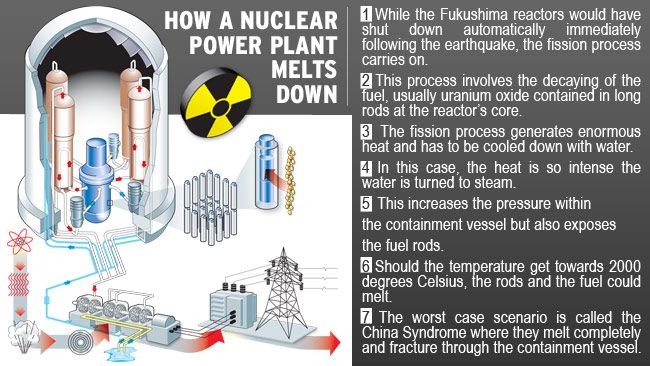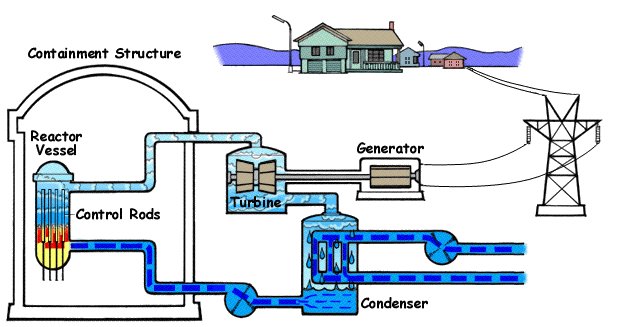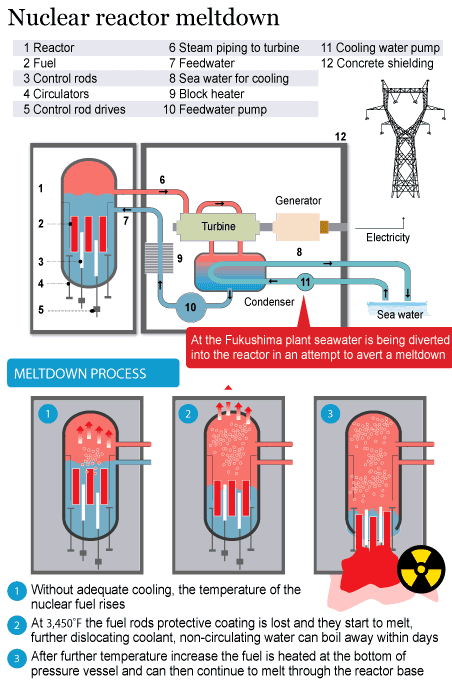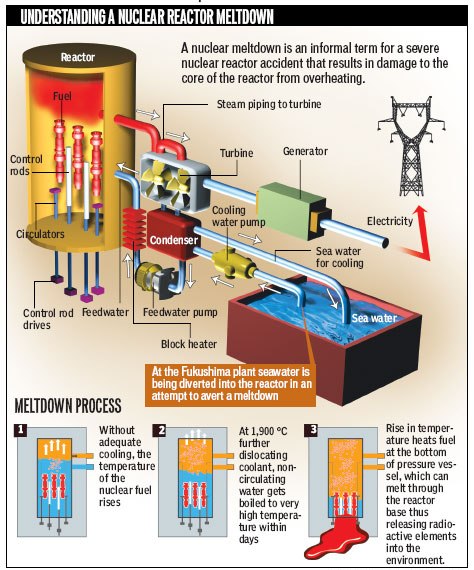
|
||||||||||||
|
|
|
Nuclear Meltdown
The term - Meltdown - refers to melting of the fuel in the reactor. Unfortunately, the term has been loosely applied to refer to any case of fuel melting, however minor. Only in several events - Three Mile Island 2 and Chernobyl - has there been significant fuel melting and only in the case of Chernobyl were there significant offsite releases. Overheating of the fuel typically can be caused only if there is an inability to remove heat from the fuel. Two situations are the only likely causes: Loss of coolant in the
reactor cooling system followed by a failure of the emergency core cooling
systems to operate
If a meltdown does occur, a release of radioactive materials to the environment can occur ONLY IF there is also a major failure of the containment structure. For this to occur, the following would also have to happen: Overpressure of the
containment Steam explosion in the
reactor vessel or a dropping of at least 20% of the fuel mass of a molten
core Failure of the reactor to
shutdown when required such that it continues to produce heat at a high
rate OR a major amount of coolant is lost from the reactor cooling system,
A meltdown occurs when fuel has overheated, melted, and flowed to the bottom of the reactor vessel, where it will burn its way through the steel and then collect on the floor of the primary containment structure. It is possible to have a meltdown without a loss of primary containment; the containment is designed to hold the melted fuel and its radioactive emissions. A loss of primary containment occurs when the integrity of the containment structure is compromised, allowing the melted fuel and/or radioactive isotopes to leak into the secondary containment. The loss of secondary containment would allow the melted fuel and/or radioactive isotopes to escape to the outside environment. “Meltdown” refers to damage
to fuel rods due to excessive heating when the reactor’s cooling systems
fail. Because of their high level of radioactivity, fuel rods in a reactor
core or a spent fuel pool generate a lot of heat even if the reactor is
not operating. So they must be surrounded by water that is circulated and
cooled to carry heat away from the rods. If something disrupts this
cooling, the fuel rods will heat up the water and eventually cause it to
boil off. If the water drops low
enough to expose a significant length of a fuel rod, it will get hot
enough that the zirconium cladding of the rod will start to oxidize (i.e,
burn). This damage to the cladding will begin to allow the release of
radioactive elements in the rod. If heating continues, the fuel pellets in
the rod will start to release much larger amounts of radioactive gases.
Eventually, the heat can get high enough that the fuel pellets will begin
to melt. If only a fraction of the fuel pellets melt, that is called a
“partial meltdown.” A partial meltdown will
release large amounts of radioactivity. In general, that radioactivity and
the damaged fuel will be contained in the steel reactor vessel, which is
itself in the reactor’s “primary containment” structure to isolate it from
the environment. That means that even if a partial meltdown occurs, it may
not lead to a large release of radioactivity into the atmosphere since it
will be confined inside the reactor. That is the situation that occurred
during the Three Mile Island nuclear accident in 1979. However, if a partial
meltdown occurs in spent fuel that is not in the reactor core but has been
moved to the spent fuel pool, the radiation released is much more likely
to get into the atmosphere. The pool is not surrounded by the same layers
of confinement as the reactor. In the case of the Japanese reactors,
explosions have damaged the reactor buildings and that would allow
radioactive gases from the spent fuel pool to travel directly into the
atmosphere. A “complete meltdown” can
occur when cooling water drops enough that the nuclear fuel in the reactor
core is entirely uncovered. If a large quantity of fuel melts, the molten
mass can run to the bottom of the metal reactor vessel, and may remain hot
enough to burn through the vessel floor. The mass would then drop onto the
concrete floor of the primary containment. In the case of the Mark I
containment used in the Japanese reactors, if the mass is large enough it
can spread to the metal containment wall and burn through it. If so, the
containment can be breached and radioactivity will escape. The concern about a full meltdown in the reactor is that it will potentially breach the primary containment structure, which would greatly increase the probability that it would escape into the atmosphere. This is different for spent fuel pools. Since the pools are already outside primary containment, a complete meltdown would not necessarily be significantly worse than a partial meltdown, although the total amount of radioactive gases released would likely be largerin the former case.
Glossary Background radiation - The radiation in the natural environment, including cosmic rays and radiation from the naturally radioactive elements, both outside and inside the bodies of humans and animals. The usually quoted average individual exposure from background radiation is 300 millirem per year. Cladding - The thin-walled metal tube that forms the outer jacket of a nuclear fuel rod. It prevents the corrosion of the fuel by the coolant and the release of fission products in the coolants. Aluminum, stainless steel and zirconium alloys are common cladding materials. Emergency feedwater system - Backup feedwater supply used during nuclear plant startup and shutdown; also known as auxiliary feedwater. Fuel rod - A long, slender tube that holds fuel (fissionable material) for nuclear reactor use. Fuel rods are assembled into bundles called fuel elements or fuel assemblies, which are loaded individually into the reactor core. Containment - The gas-tight shell or other enclosure around a reactor to confine fission products that otherwise might be released to the atmosphere in the event of an accident. Coolant - A substance circulated through a nuclear reactor to remove or transfer heat. The most commonly used coolant in the U.S. is water. Other coolants include air, carbon dioxide, and helium. Core - The central portion of a nuclear reactor containing the fuel elements, and control rods. Decay heat - The heat produced by the decay of radioactive fission products after the reactor has been shut down. Decontamination - The reduction or removal of contaminating radioactive material from a structure, area, object, or person. Decontamination may be accomplished by (1) treating the surface to remove or decrease the contamination; (2) letting the material stand so that the radioactivity is decreased by natural decay; and (3) covering the contamination to shield the radiation emitted. Feedwater - Water supplied to the steam generator that removes heat from the fuel rods by boiling and becoming steam. The steam then becomes the driving force for the turbine generator. Nuclear Reactor - A device in which nuclear fission may be sustained and controlled in a self-supporting nuclear reaction. There are several varieties, but all incorporate certain features, such as fissionable material or fuel, a moderating material (to control the reaction), a reflector to conserve escaping neutrons, provisions for removal of heat, measuring and controlling instruments, and protective devices. Pressure Vessel - A strong-walled container housing the core of most types of power reactors. Pressurizer - A tank or vessel that controls the pressure in a certain type of nuclear reactor. Primary System - The cooling system used to remove energy from the reactor core and transfer that energy either directly or indirectly to the steam turbine. Radiation - Particles (alpha, beta, neutrons) or photons (gamma) emitted from the nucleus of an unstable atom as a result of radioactive decay. Reactor Coolant System - (see primary system) Secondary System - The steam generator tubes, steam turbine, condenser and associated pipes, pumps, and heaters used to convert the heat energy of the reactor coolant system into mechanical energy for electrical generation. Steam Generator - The heat exchanger used in some reactor designs to transfer heat from the primary (reactor coolant) system to the secondary (steam) system. This design permits heat exchange with little or no contamination of the secondary system equipment. Turbine - A rotary engine made with a series of curved vanes on a rotating shaft. Usually turned by water or steam. Turbines are considered to be the most economical means to turn large electrical generators. Credit: U.S. Department of Energy, International Atomic Energy Agency, U.S. Nuclear Regulatory Commission, Nuclear Science Division ---- Lawrence Berkeley National Laboratory, Penn State Radiation Science and Engineering Center, American Nuclear Society, European Commision, The Union of Concerned Scientists |








